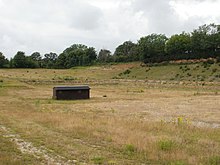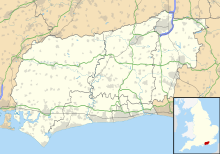Boxgrove Quarry
| Site of Special Scientific Interest | |

One of the quarries at Eartham Pit.
|
|
| Area of Search | West Sussex |
|---|---|
| Grid reference | SU923087 |
| Coordinates | 50°52′13″N 0°41′15″W / 50.870309°N 0.687409°WCoordinates: 50°52′13″N 0°41′15″W / 50.870309°N 0.687409°W |
| Interest | Geological |
| Area | 9.83 ha (24.3 acres) |
| Notification | 1997 |
| Natural England website | |
Amey's Eartham Pit is the original name for the internationally important Lower Palaeolithic archaeological site of Boxgrove in the English county of West Sussex. Today it is a disused, and largely infilled, sand and gravel quarry. Part of the site was designated a Site of Special Scientific Interest. When excavations began in 1982 flint tools 500,000 years old were discovered, which at that time was the oldest evidence of humans ever discovered in the UK. In 2005 flint tools 700,000 years old were discovered at Pakefield, and in 2010 flint tools at least 800,000 years old were discovered at Happisburgh. However Boxgrove remains a site of international archaeological importance because of the discovery in 1994 and 1995 of 500,000-year-old early human fossils, which remain the oldest such fossils ever discovered in the UK. The other key paleolithic sites in the UK are Swanscombe, Pontnewydd, Kents Cavern, Paviland, and Gough's Cave.
Parts of the site complex were excavated between 1982 and 1996 by a team led by Mark Roberts of the Institute of Archaeology, University College London. The site is situated in an area that features a buried chalk cliff that overlooked a flat beach (which contained a waterhole) stretching around half a mile (1 km) south to the sea.
The site is important for many reasons, including the degree of preservation of ancient landsurfaces, the impressive total extent of the palaeo-landscape beyond the quarries(over 26 km wide), its huge quantity of well-preserved animal bones, its numerous flint artifacts, and its hominin bones which are among some of the most ancient found yet in Europe. Several of the animal bones are the oldest found specimens of their species, such as the wing bone of the great auk found at the site in 1989. The combination of bones, stone artifacts, and the geology of the landscape gives a very complete picture of the coastal plain as it existed half a million years ago.
...
Wikipedia

